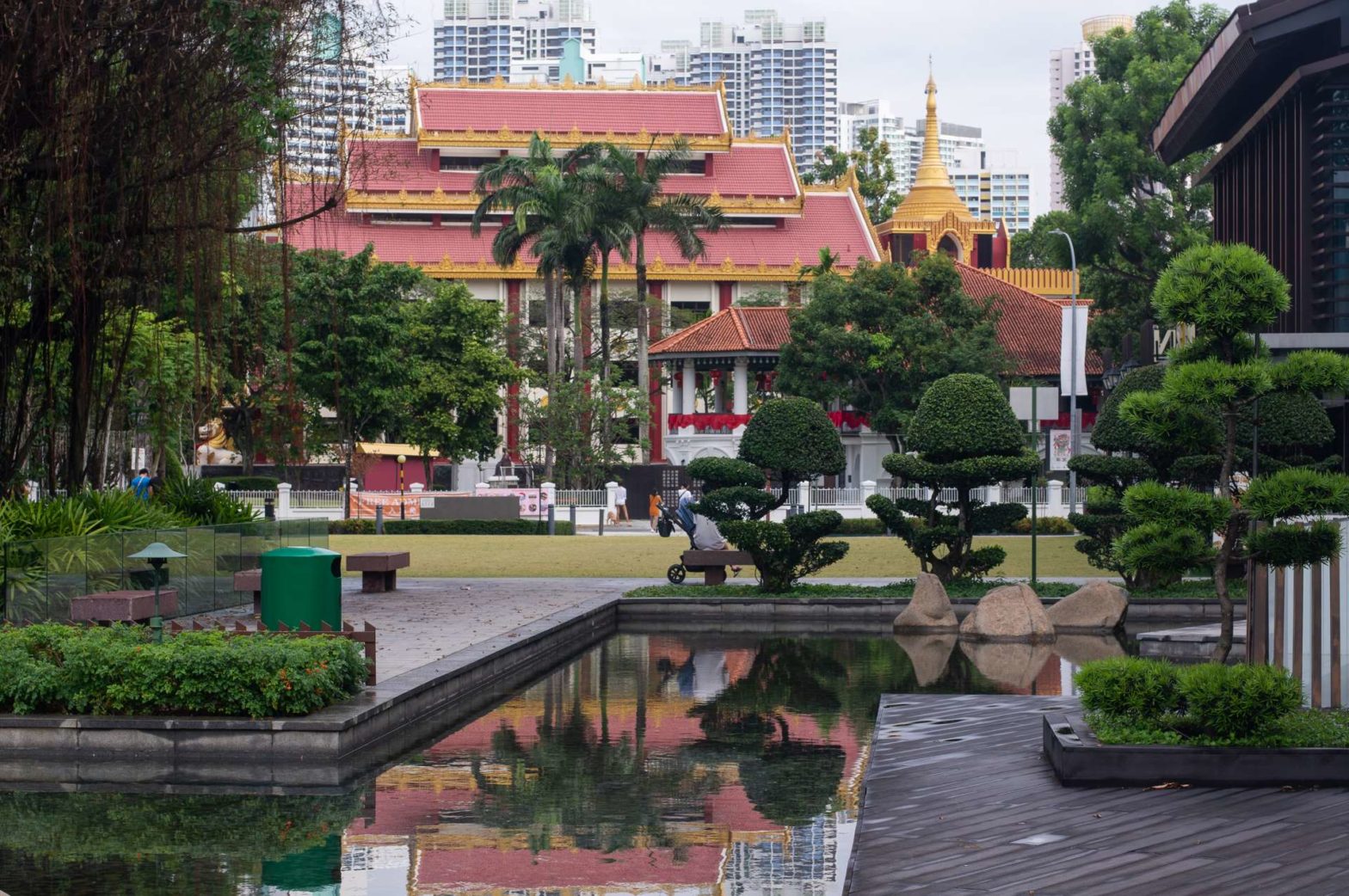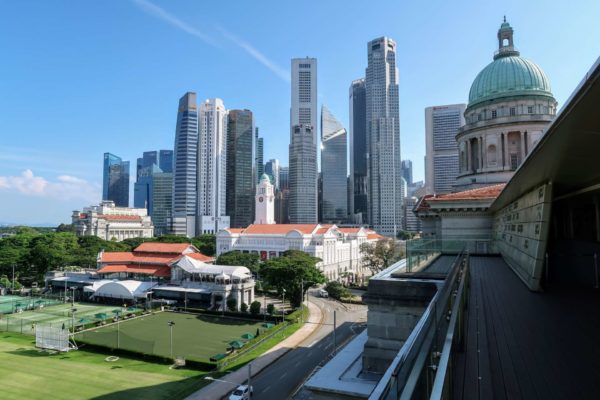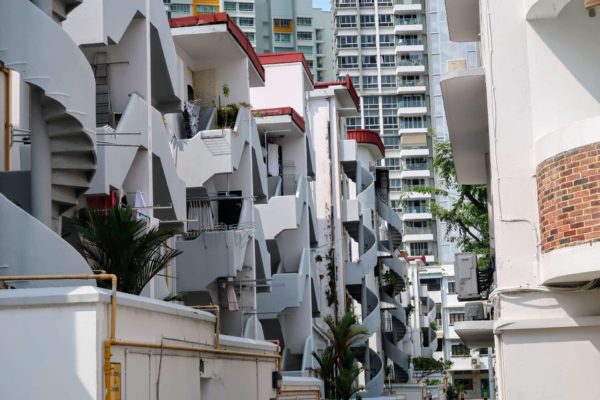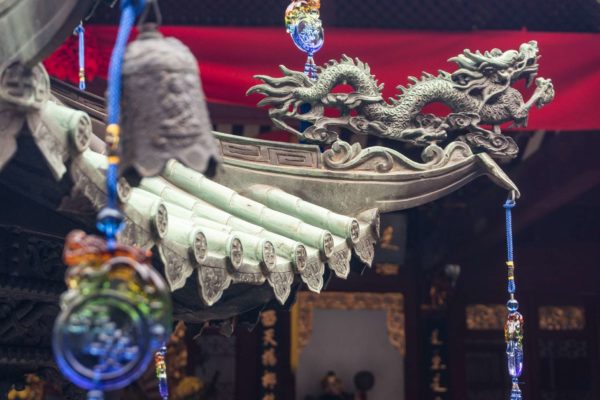By Vicky · Published Feb. 6th, 2022 · Updated Nov. 9th, 2023
When you buy through links highlighted with an asterisk (*) on this site, we may earn a small affiliate commission at no cost to you.
Explore Balestier and southern Toa Payoh on this heritage trail and finish by walking along a river. This walk takes inspiration from the official Balestier Heritage Trail but adds on some extra sights. The roads you walk along are large and full of traffic so not the best places to walk and the sights are mostly only of minor interest, but it’s a good way to explore the area.
Page Contents:
How to get to Balestier Heritage Trail
This hike starts from Novena MRT station on the red North-South line. There’s also a convenient bus stop just outside the station. It ends at Boon Keng MRT station on the purple North-East line.
Balestier Heritage Trail Map
Get the route by downloading the .gpx or .kml file below. For navigation with Maps.me on your mobile phone, simply download the .kml file and open to add it to the Maps.me bookmarks.
Tips for Balestier Heritage Trail
- Sun Yat Sen Memorial Hall is open from 10am-5pm Tue-Sun.
- Lian Shan Shuang Lin Monastery can be busy on the weekends, especially around Chinese festival times.
- Balestier Market is a hawker centre for a tasty mid-walk break.
- Early mornings or late afternoons are a good time to enjoy this walk to avoid the heat of the day.
Attractions on the Balestier Heritage Trail
On this walking trail you’ll see the main sights and attractions of Balestier and southern Tao Payoh:
- Conservation House
- Kuang Chee Tng Buddhist Temple
- Goh Chor Tua Pek Kong Temple
- Art Deco Shophouses
- Sing Hon Loong Bakery
- Sim Kwong Ho Shophouses
- Pre-war Terraced Houses
- Kwan Yow Luen Shophouses
- Thong Teck Sian Tong Lian Sin Sia Temple
- Balestier Market
- Sun Yat Sen Memorial Hall
- Maha Sasana Ramsi Burmese Buddhist Temple
- Toa Payoh Town Park
- Poh Chung Tian Chor Sian Tong
- Lian Shan Shuang Lin Monastery
- Masjid Hajjah Rahimabi Kebun Limau
- Whampoa River Park Connector
- Central Sikh Gurdwara / Temple
Balestier Heritage Trail Route
This walking trail starts from Novena MRT station, Exit B.
Directions: From Novena MRT head left down Thomson Road and follow the road as it bends around to the left to become Moulmein Road. Soon on the left-hand side you will see a white and blue conservation house.
1. Conservation House
This charming old house once belonged to a Hakka businessman. It’s now part of a hospital. There’s another old bungalow just next door with a similar colour scheme.
Directions: Continue walking down Moulmein Road and look to your right.
The two tall but narrow buildings next to each other are both religious buildings, Sathya Sai Baba Centre and Moulmein Church of Christ. Sathya Sai Baba was an influential Indian Guru who lived from 1926 to 2011. His devotees set up many centres around the globe which are now involved in charity projects such as setting up hospitals and providing clean drinking water to the poor.
Directions: Just next to these two narrow buildings is a very obvious temple.
2. Kuang Chee Tng Buddhist Temple
This is a large Buddhist temple dating from 1953. The main deity worshipped here is Sakyamuni Buddha, i.e. historical Buddha. The monks and community associated with this temple historically spoke Teochew, a dialect of Chinese from Guangdong in Southern China. Today this dialect is slowly dying out and being replaced by Mandarin.
Directions: Continue along Moulmein Road for another 450 metres to reach Balestier Road and take this road to the left. In a couple of hundred metres, you’ll see a small, very red temple on the left.
3. Goh Chor Tua Pek Kong Temple
This historic temple was built in 1847 by Hokkien workers from Fujian Province in southern China. The architectural style of this temple mimics that of contemporary Fujian. If you study the temple carefully you’ll see many auspicious animals such as dragons and fish. The name of the temple can be divided into two parts: Goh Chor was the old name for this area, and Tuo Pek Kong which means ‘Grand Uncle’, a deity from the folk religions of Southeast Asia who is known as the God of Prosperity.
Directions: The next stop is just opposite the temple on the righthand side of the road.
4. Art Deco Shophouses
This pair of unique art deco shophouses date from the 1950s. They have some classic art deco features such as the strong vertical lines and narrow windows. At the time these looked very modern but now they are reminiscent of the past.
Directions: 50 metres further along the road, Whampoa Drive branches off to the right. Head a short distance down this road to the famous Sing Hon Loong Bakery.
Shoes for Paved Paths
The majority of hikes in Singapore are on paved paths, so your hiking shoes need good damping. For hikes that are entirely on pavement like this one, you may prefer to wear trainers with reasonable grip. We really like the fit and feel of Salomon shoes. Their running shoes give you plenty of damping on paved paths:
Salomon Men‘s Sonic 4 Balance Running Shoes on Amazon*.
Salomon Women‘s Sonic 4 Balance W Running Shoes on Amazon*.
Check out the complete list of hiking gear needed for Singapore:
5. Sing Hon Loong Bakery
This is a very traditional bakery that still makes bread in an old-fashioned time-honoured way. The bread they make is high-quality, spongey and light. It’s hand-made all the way in a very labour-intensive process. When we were there, bags and bags full of flour were being unloaded from a lorry and lifted to the back of the shop. Do pop in and buy a loaf, they’re very good value at less than $2.
Directions: Return to the main Balestier Road and continue for another 50 metres. On the right-hand side of the road, you’ll see the next stop.
6. Sim Kwong Ho Shophouses
This row of ornate, colourful shophouses was built in 1926 in the style called Chinese Baroque. This means they have some neoclassical architectural elements such as triangular pediments (top bits) and columns, combined with local ornaments and detail of native flowers and animals.
Directions: On the opposite side of the road from these Shophouses, head up Pegu Road for a few more shophouses before taking the little alleyway over to Martaban Road and the next stop.
History of Balestier
The Balestier area gets its name from Joseph Balestier who owned a large sugar cane estate here. He also became the first American Consul in Singapore. Balestier Road and its surroundings used to be covered in sugarcane Plantations. In the mid-1800s tigers still roamed the jungle and ate unlucky plantation workers.
Still in the early 1900s it was a quiet, countryside area with muddy lanes and small villages. That began to change when wealthy merchants relocated from the city centre to build mansions along Balestier Road. These were followed by more merchants who set up shophouses nearby and the road became a bustling centre, similar to today.
7. Pre-war Terraced Houses
The terraced houses on Martaban Road were all built before the Second World War, mainly in the 1920s and 30s. They technically aren’t shophouses because their lower floors were always designed for living rather than commercial shop space. The row of houses was renovated in 2003 to restore them to their former glory.
Directions: Return to the main road and continue left for about 500 metres to reach some more shophouses in a different style.
8. Kwan Yow Luen Shophouses
Named after their designer, these shophouses on the corner have rather extravagantly carved exteriors. Check out the triangular pediment at the top and you’ll see two lions fighting in the middle, and two buffalos standing guard on the little pillars on either side. Elsewhere among the carvings, you’ll find peacocks, flowers and dragons.
Directions: Head right down the side street to make a small loop around the block of small landed houses. As you walk back to Balestier Road you’ll see a temple on your right.
9. Thong Teck Sian Tong Lian Sin Sia Temple
This is a Buddhist-Taoist temple that emphasizes compassion and helping the poor and needy. For this cause, the temple operates a medical clinic and elderly people’s home that’s free for those who need these services.
Directions: Almost opposite on Balestier Road you’ll see the low red roof of the market.
10. Balestier Market
This historic market dates back to 1922 when it was built as a rural wet market for local planters to sell their produce. After renovation in the 50s, it continued to sell fresh food and meat, though in 2003 it was converted to a hawker centre and the fresh produce stalls mainly closed. There are many stalls here with plenty of Malay and Chinese food options.
Directions: Continuing along the road, 200 metres further you’ll see Zhongshan Park on the right. Walk through this park and you’ll see the following two stops.
11. Sun Yat Sen Nanyang Memorial Hall
Key Information: Open from 10am-5pm Tue-Sun. It’s free for locals and $8 for others, with reduced rates of $5 for students and seniors.
The Sun Yat Sen Memorial Hall is an old Malay Palace-style building from 1902 that contains a small museum about Sun Yat Sen. He was the leader of the Chinese Revolutionary Alliance who made this house their base in Southeast Asia. They dedicated themselves to overthrowing Qing Dynasty Rule in China in order to establish a republic. The museum is slightly confusing, it’s worth reading up about Sun Yat Sen in advance if you visit.
12. Maha Sasana Ramsi Burmese Buddhist Temple
This distinctive temple towers just behind the Memorial Hall. Two huge dragon/lion statues guard the entrance, with a golden buddha statue floating in the middle. This is the main Burmese Buddhist temple in Singapore and the architecture has distinctive Burmese features including a golden pagoda on the top.
Directions: After admiring the temple, head back around the road by the Memorial Hall. In a few hundred metres you’ll see a bridge over a canal that leads you into the Toa Payoh Town Park.
13. Toa Payoh Town Park
This small park contains some impressive water features, though the sound of the highway you’ve just crossed remains loud throughout. This park was actually developed in the 1970s, and its most famous landmark is the 25-metre-high Observation Tower.
Directions: After looping around the park, head along Lor 6 Toa Payoh Road past the recreation centre. As the road bends to the left, cut left into an HDB estate when you see a bright red temple from the road.
14. Poh Chung Tian Chor Sian Tong
This colourful temple looks slightly out of place surrounded by towering HDB blocks on three sides. My favourite feature was the two stone horses standing on either side of the entrance. They even had carrot offerings at their feet!
Directions: Turn right down the road behind the temple and in a few hundred metres you’ll reach the entrance to a large monastery.
15. Lian Shan Shuang Lin Monastery
The name of this historic monastery means ‘Twin Grove Monastery on Lotus Hill’. It contains one of the oldest temples in Singapore, though today it’s just by the edge of a very large highway so has lost some of its peacefulness. There are several different buildings in the monastery complex, such as Mahavira Hall, the Hall of Heavenly Kings and the Bell and Drum Towers. It’s open from 6:30am-5pm every day.
Directions: From the roundabout just outside the monastery entrance, take the steps up to the bridge across the highway. Once down the steps on the other side, continue to Jalan Bahagia Road. You’ll see the mosque a few hundred metres further along this road.
16. Masjid Hajjah Rahimabi Kebun Limau
This mosque by the river was built in 1984. Kebun Limau means ‘Lime Garden’ in Malay, as this area used to grow lots of limes.
Directions: Cross over the river just after the mosque and walk left along Whampoa Park Connector to follow along the edge of the river.
17. Whampoa River Park Connector
Strolling along by the water is rather pleasant, and this park connector is never really busy. There are loads of fish in the river here and we saw many birds such as kingfishers, herons and egrets waiting to pounce on their lunch. We also came across a bird cage hanging area where often older men come to hang their songbirds. Both birds and men thereby get the opportunity to talk with each other.
Directions: After just over 1 kilometre of walking along the river you’ll reach Serangoon Road. Turn right here and 300 metres later you’ll reach the final stop on this heritage trail of Balestier.
18. Central Sikh Gurdwara / Temple
Sikhs built this temple as the first Gurdwara in Singapore. It used to be located elsewhere but moved to its present site on Serangoon Road in 1986. There are roughly 15,000 Sikhs in Singapore and this temple is one of their main sites of worship.
Directions: Boon Keng MRT station (on the purple north-west line) is just opposite this temple. There are also several bus stops nearby along Serangoon Road.
If you want to experience another Singapore heritage trail, why not check out our Kampong Glam Walking Trail, Little India Walking Trail or Tiong Bahru Walking Trail. For more hikes, check out our Singapore Hiking Guide.
FAQS – Balestier Heritage Trail
Balestier is known for the Sun Yat Sen Memorial Hall, its most famous landmark. There are also many temples, shophouses of various different styles here, and several traditional bakeries.
Balestier is named after a person, Joseph Balestier, who was the owner of a large sugar cane plantation in the area in the 1800s and also the first American Consul to Singapore.
To get to Balestier, take the MRT to Novena or Toa Payoh MRT stop. Balestier is right in between these two stops on the Red North-South line. Many buses also stop just along Balestier Road.







